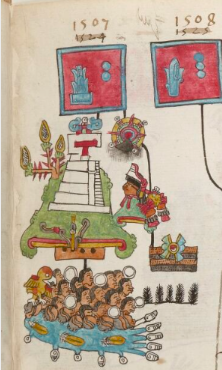atlan miquiliztli (TR42r)
This colorful painting of the iconographic example extracted from the Telleriano-Remensis codex provides a visual for a drowning (atlan miquiztli), or literally, death in the water. We have provided the Nahuatl here, drawing from our dictionary, because we only have the Spanish-language gloss. This image shows a group of about 17 men's heads in profile, facing toward the viewer's right. The men's skin is brown and their hair is black. Their eyes are all closed, which is the indicator for death (miquiztli). Sprinkled among these heads are six round, white, war shields, which conveys the message that they are warriors. Seven gray and brown stones cluster near the men's heads, possibly having played a role in their sinking and drowning. Below the stones is a wide flow of water (representing "atlan") with five, turbinate, white shells at the end of the flow (on the right) and two more shells and three droplets splashing off the flow along the bottom. Three golden feathers appear on the water, and a bird of the same gold color--plus red--stands on one of the rocks. Its hooked beak is open.
Stephanie Wood
The Spanish-language gloss for this event says "se ahogaron" (they drowned). The number of people who drowned is declared to be 2000, judging from the contextualizing image, which connects this scene to five signs (resembling little black trees) that each represent the number four hundred. The contextualizing image also shows that this happened in 1507, several years before Spanish invaders were on the scene.
Stephanie Wood
se ahogaron
ca. 1550–1563
Jeff Haskett-Wood
ahogamientos, drownings, Oaxaca, Mixteca, warriors, guerreros, rodelas, shields, plumas, feathers, piedras
atlan miquiliz(tli), death by drowning in water, https://nahuatl.wired-humanities.org/content/atlan-miquiliztli
un ahogamiento
Stephanie Wood
Telleriano-Remensis Codex, folio 42 recto, MS Mexicain 385, Gallica digital collection, https://gallica.bnf.fr/ark:/12148/btv1b8458267s/f109.item.zoom
The non-commercial reuse of images from the Bibliothèque nationale de France is free as long as the user is in compliance with the legislation in force and provides the citation: “Source gallica.bnf.fr / Bibliothèque nationale de France” or “Source gallica.bnf.fr / BnF.”





